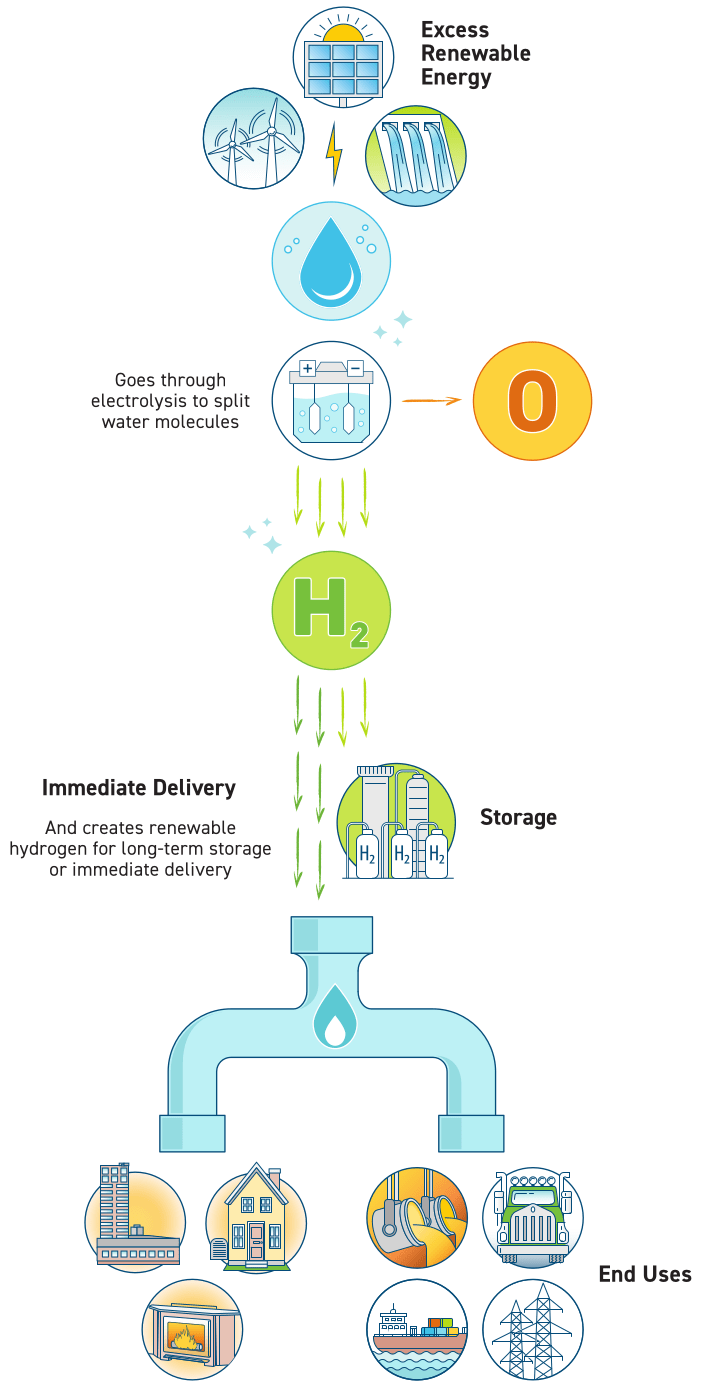Hydrogen is a key piece of our plan to reach our goal of delivering carbon neutral energy by 2050. It’s a versatile energy source that can do many of the jobs natural gas does today but with less of a climate impact. In fact, it emits no carbon emissions when burned and can be blended with natural gas into existing pipelines, distributed in a dedicated pipe network, or combined with waste carbon dioxide and converted to synthetic natural gas.[1]https://www.hydrogen.energy.gov/docs/hydrogenprogramlibraries/pdfs/us-national-clean-hydrogen-strategy-roadmap.pdf?Status=Master
We see unprecedented opportunities in the future for bringing hydrogen into our energy mix at a large scale and we are working hard on a variety of options to help our customers decarbonize. Emerging technologies can also play a role in decarbonizing non-renewable gas supplies through the direct capture of carbon dioxide at the point of combustion. These emissions can be sequestered or utilized, giving rise to the category of carbon capture, utilization, and storage (CCUS).
What is hydrogen?
Hydrogen is an odorless and colorless chemical element. Though abundant, hydrogen does not exist independently in nature and therefore is produced from various energy sources and methods.[2]https://www.nrel.gov/research/eds-hydrogen.html
A growing amount of gas utilities in North America, the United Kingdom and Europe have started to blend hydrogen into portions of their distribution systems to demonstrate its viability as an emissions reduction solution.
Outside research and company field tests show that blends upwards of 20% hydrogen are compatible with existing natural gas infrastructure and appliances.[3]Examples of research include, https://www.nrel.gov/docs/fy13osti/51995.pdf; Glanville P, Fridlyand A, Sutherland B, Liszka M, Zhao Y, Bingham L, Jorgensen K. Impact of Hydrogen/Natural Gas Blends on Partially Premixed Combustion Equipment: NOx Emission and Operational Performance. Energies. 2022; 15(5):1706.https://doi.org/10.3390/en15051706; Suchovsky, C. J., Ericksen, L., Williams, T., & Nikolic, D. (2021, May). Appliance and equipment performance with hydrogen-enriched ... - CSA group. Retrieved July 18, 2022, from https://www.csagroup.org/wp-content/uploads/CSA-Group-Research-Appliance-and-Equipment-Performance-with-Hydrogen-Enriched-Natural-Gases.pdf/For over 40 years Hawai'i Gas has delivered a blend of gas to customers with up to 15% hydrogen using standard natural gas equipment and infrastructure.[4]https://www.hawaiigas.com/sustainability/hydrogen
Our hydrogen and carbon capture projects
Starting with our own facility
Starting with our own facility
We have been successfully blending hydrogen at our largest facility for more than two years, starting out at 5% and now blending 20% hydrogen directly into our pipes to test our distribution system materials, leak detection equipment and to ensure normal operations of end uses, including furnaces, water heaters, fireplaces, and cooktops.Exploring hydrogen production technologies
Exploring hydrogen production technologies
We’re exploring a variety of different types of technologies that produce clean hydrogen[5]Under the federal Inflation Reduction Act (IRA) “clean hydrogen” has an emissions standard of 4kgCO2e/kgH2 or less for hydrogen production.and solid carbon from natural gas (methane pyrolysis) to help us deliver lower carbon energy to our customers. We’ll likely need a few different options to not only satisfy demand, but also to fit with customers’ equipment, processes, and available space.
- Modern Hydrogen – We are partnering with Modern Hydrogen, headquartered just outside of Seattle, on a project that uses only natural gas and air as inputs – the technology does not require any electricity (other than for controls and monitoring), water, or consumable catalyst – to produce clean hydrogen and solid carbon (sequestered). Launched in 2024, the clean hydrogen is blended into our distribution network and the solid carbon resulting from the process will be used to make asphalt – closing the loop on emissions and providing a secondary market value.
- Hycamite – We are partnering with Finland-based Hycamite to identify opportunities to use their technology to produce clean hydrogen via methane pyrolysis. They offer a significantly larger scale that may help us decarbonize our largest customers as efficiently as possible.
Hydrogen projects underway around the globe
More than a dozen North American utilities are actively working on hydrogen as a resource. Some are already safely delivering hydrogen-blended gas to customers, such as Enbridge Gas, New Jersey Natural Gas, and CenterPoint Energy, and others are advancing pure research and development, like SoCalGas, who is developing a clean hydrogen home.[6]/https://newsroom.socalgas.com/press-release/socalgas-successfully-tests-microgrid-demonstration-project-in-downey
The HyDeploy consortium in the UK is demonstrating the potential for hydrogen blends of up to 20%, beginning with a Keele University project (2019-2021) that achieved a 15% blend delivered to ~100 buildings. The success of the Keele University project led to the second phase which successfully expanded delivery to a 650-home project. Now, HyDeploy is working on its submission to the UK Government for final approval of the use of hydrogen blending across the gas distribution network.[7]/https://hydeploy.co.uk/project-phases/#phase-1-keele
In Italy, the largest gas utility, SNAM, successfully ran a trial blend of 5% and then 10% in sections of its pipelines system.[8]https://www.bakerhughes.com/company/news/snam-and-baker-hughes-successfully-complete-first-trial-use-hydrogen-fuel-gasTheir work continues.
Answers to customer questions about hydrogen
How can hydrogen be used to lower emissions?
What types of hydrogen production is NW Natural focused on?
How does NW Natural plan to incorporate clean hydrogen?
Is hydrogen more expensive?
